Wide q waves in leads ii Study guides, Class notes & Summaries
Looking for the best study guides, study notes and summaries about Wide q waves in leads ii? On this page you'll find 246 study documents about Wide q waves in leads ii.
Page 2 out of 246 results
Sort by
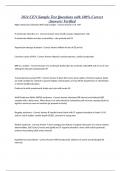
-
2024 CEN Sample Test Questions with 100% Correct Answers/ Verified
- Exam (elaborations) • 33 pages • 2024
- Available in package deal
-
- $10.99
- + learn more
2024 CEN Sample Test Questions with 100% Correct Answers/ Verified Right ventricular infarction (RVI) lead changes - Correct Answer II, III, AVF R ventricular infarction s/s - Correct Answer clear breath sounds, hypotension, JVD. R ventricular dilation and dec contractility>> dec preload and CO Reperfusion therapy standard - Correct Answer Within 60 min of ED arrival Common causes of PEA - Correct Answer Hypoxia, tension pneumo, cardiac tamponade BNP as a marker - Correct Ans...
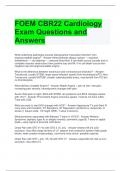
-
FOEM CBR22 Cardiology Exam Questions and Answers
- Exam (elaborations) • 14 pages • 2024
-
- $12.99
- + learn more
FOEM CBR22 Cardiology Exam Questions and Answers What underlying pathologic process distinguishes myocardial infarction from angina/unstable angina? - Answer-Atherosclerotic plaque rupture → exposed endothelium → clot attaches → reduced blood flow; if cell death occurs (usually due to complete vascular obstruction) then positive trop and MI; if no cell death occurs then negative trop and angina/unstable angina. What is the difference between transmural and nontransmural infarction? -...
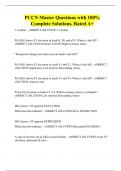
-
PCCN Master Questions with 100% Complete Solutions, Rated A+
- Exam (elaborations) • 40 pages • 2024
-
- $13.99
- + learn more
1. Cardiac - cORRECT sOLUTION 1. Cardiac Pt's EKG shows ST elevation in leads II, III, and aVF. Where is the MI? - cORRECT sOLUTION Inferior wall MI, Right coronary artery "Reciprocal changes are often seen ini leads I and aVL" Pt's EKG shows ST elevation in leads V1 and V2. Where is the MI? - cORRECT sOLUTION Septal area, Left Anterior Descending Artery Pt's EKG shows ST elevation in leads V3 and V4. Where is the MI? - cORRECT sOLUTION Anterior area Pt has ST elevation in le...

-
Foundations CBR20 – Cardiology Exam Questions With Answers
- Exam (elaborations) • 25 pages • 2024
-
- $11.09
- + learn more
Foundations CBR20 – Cardiology Exam Questions With Answers What underlying pathologic process distinguishes myocardial infarction from angina/unstable angina? Atherosclerotic plaque rupture → exposed endothelium → clot attaches → reduced blood flow; if cell death occurs (usually due to complete vascular obstruction) then positive trop and MI; if no cell death occurs then negative trop and angina/unstable angina What is the difference between transmural and non-transmural infarctio...
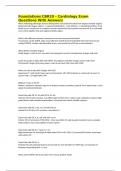
-
Foundations CBR20 – Cardiology Exam Questions With Answers
- Exam (elaborations) • 25 pages • 2024
-
- $10.59
- + learn more
Foundations CBR20 – Cardiology Exam Questions With Answers What underlying pathologic process distinguishes myocardial infarction from angina/unstable angina? Atherosclerotic plaque rupture → exposed endothelium → clot attaches → reduced blood flow; if cell death occurs (usually due to complete vascular obstruction) then positive trop and MI; if no cell death occurs then negative trop and angina/unstable angina What is the difference between transmural and non-transmural infarctio...

-
PCCN Master Questions with 100% Correct Solutions
- Exam (elaborations) • 42 pages • 2024
- Available in package deal
-
- $13.49
- + learn more
PCCN Master Questions with 100% Correct Solutions 1. Cardiac - Correct Answer ️️ -1. Cardiac Pt's EKG shows ST elevation in leads II, III, and aVF. Where is the MI? - Correct Answer ️️ -Inferior wall MI, Right coronary artery "Reciprocal changes are often seen ini leads I and aVL" Pt's EKG shows ST elevation in leads V1 and V2. Where is the MI? - Correct Answer ️️ -Septal area, Left Anterior Descending Artery Pt's EKG shows ST elevation in leads V3 and V4. Where is the MI...

-
Barron/Elsevier CCRN practice test Questions and Answers well Explained Latest 2024/2025 Update 100% Correct.
- Exam (elaborations) • 29 pages • 2024
- Available in package deal
-
- $7.99
- + learn more
How does COPD result in atrial fibrillation and predisposition to PEs? - COPD causes pulmonary hypertension, right ventricular hypertrophy, and right atrial enlargement. The right atrial enlargement causes stretching of the atrial tissue and frequently results in atrial dysrhythmias. SA blocks, second-degree AV block type I, and third-degree AV heart block at the level of the AV node would occur in _______________ occlusion - RCA (as seen in inferior wall MIs) There is (more/less) risk of b...
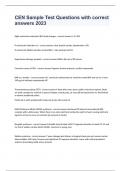
-
CEN Sample Test Questions and answers already passed 2024
- Exam (elaborations) • 33 pages • 2024
-
Available in package deal
-
- $16.49
- + learn more
CEN Sample Test Questions and answers already passed 2024 Right ventricular infarction (RVI) lead changes - correct answer II, III, AVF R ventricular infarction s/s - correct answer clear breath sounds, hypotension, JVD. R ventricular dilation and dec contractility>> dec preload and CO Reperfusion therapy standard - correct answer Within 60 min of ED arrival Common causes of PEA - correct answer Hypoxia, tension pneumo, cardiac tamponade BNP as a marker - correct answer of L ...
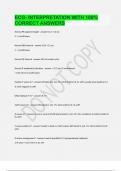
-
ECG- INTERPRETATION WITH 100% CORRECT ANSWERS.
- Exam (elaborations) • 19 pages • 2023
- Available in package deal
-
- $13.99
- + learn more
Normal PR segment length 0.12 - 0.2 sec 3 - 5 small boxes Normal QRS interval 0.06 - 0.1 sec 1 - 3 small boxes Brainpower Read More Previous Play Next Rewind 10 seconds Move forward 10 seconds Unmute 0:02 / 0:15 Full screen Normal QT interval 40% of cardiac cycle Normal P amplitude & duration < 0.12 sec (3 small boxes) < 0.25 mV (2.5 small boxes) Positive P waves in? left lateral (I, aVL, V5, V6) & inferior (II, III, aVF); usually most posi...
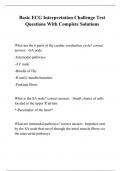
-
Basic ECG Interpretation Challenge Test Questions With Complete Solutions
- Exam (elaborations) • 24 pages • 2023
-
Available in package deal
-
- $10.99
- + learn more
What are the 6 parts of the cardiac conduction cycle? correct answer: -SA node -Internodal pathways -AV node -Bundle of His -R and L bundle branches -Purkinje fibers What is the SA node? correct answer: -Small cluster of cells located in the upper R atrium *-Pacemaker of the heart* What are internodal pathways? correct answer: Impulses sent by the SA node that travel through the atrial muscle fibers via the intra-atrial pathways Allows for simultaneous depolarization and contra...

Do you wonder why so many students wear nice clothes, have money to spare and enjoy tons of free time? Well, they sell on Stuvia! Imagine your study notes being downloaded a dozen times for $15 each. Every. Single. Day. Discover all about earning on Stuvia


